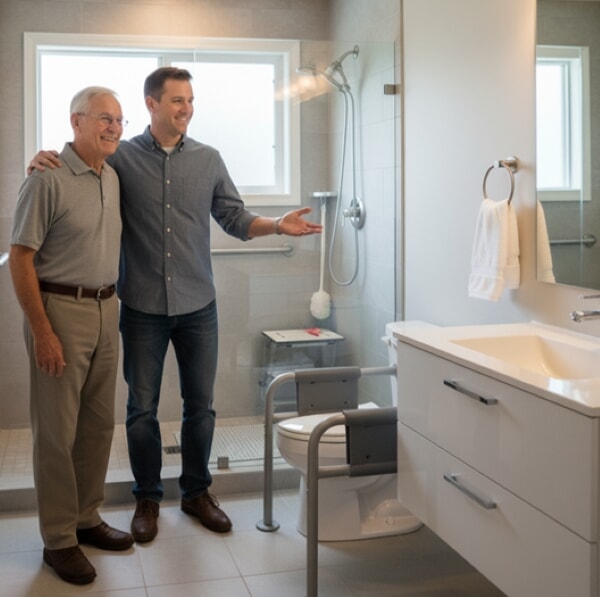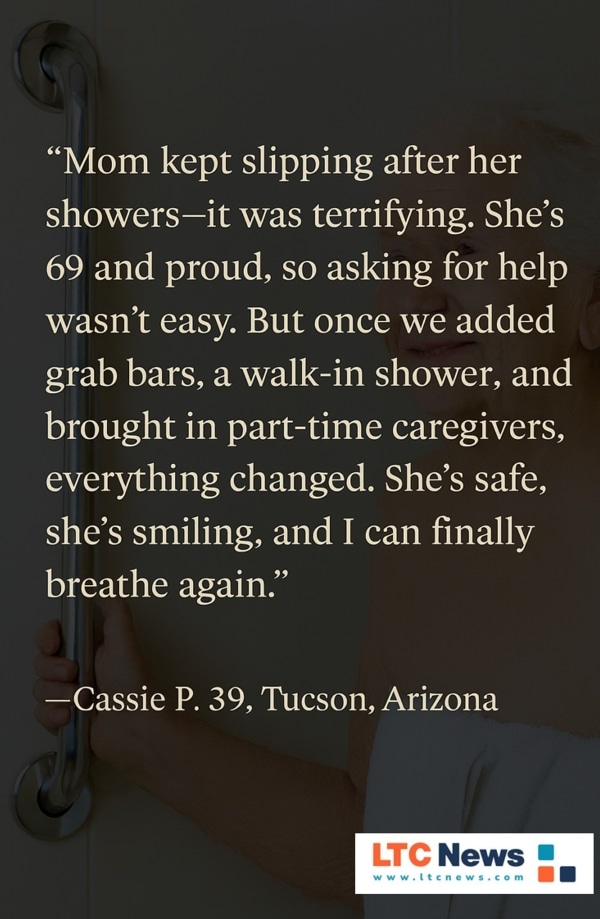How To Help Your Parent Keep an Independent Bathroom Routine

You’ve likely witnessed the moment when your parent, someone who has cared for you and handled life’s routines for decades, hesitates before walking to the bathroom. At that moment, you may feel a knot: you want them to keep their dignity and independence, but you worry about the risks they face.
It’s a familiar scenario for many adults who are supporting aging parents. Helping your parent stay safe at home doesn’t mean taking over, but it means creating conditions so they can continue to manage on their own terms.
Bathroom safety is a key piece of that puzzle. Falls among older adults are common and serious. The Centers for Disease Control and Prevention (CDC) reports that for U.S. adults 65 and older, falls are the leading cause of injury-related death.
In 2021 alone, more than 38,000 older adults died because of a fall. Another CDC report shows that of nonfatal bathroom injuries treated in U.S. emergency departments in 2008, about 81 % were caused by falls, with rates increasing steeply with age. Unfortunately, these accidents result in the need for full-time extended care, perhaps at home with professional caregivers, but often into a facility, even a nursing home.
You can't avoid aging, but you can help an older family member remain safer and more independent for longer. The bathroom can be the danger zone. For aging-in-place to continue comfortably and safely, the bathroom demands upgrades.
Many of us can take the task of going to the bathroom alone for granted, but for older adults, this essential part of their daily routine might be anything but simple.
There are several ways to support your parents’ desire to stay at home and maintain their independence, dignity, and safety in this private space.
Create a Safe Environment
A safe environment is the platform for independence. Especially in the bathroom, hazards abound: low visibility, slick surfaces, tight spaces, and awkward transitions. That’s why even modest changes can significantly reduce risk.
Safety is the foundation of independence. Low visibility, tight spaces, and wet surfaces are all common hazards in a bathroom. If remodeling is an option, designing a bathroom with aging-in-place in mind can help you build in solutions to many of these problems.
However, even small additions to existing spaces can greatly improve safety—not just for your parent, but for everyone who uses that space.
How to strengthen the environment:
- Install grab bars near the toilet, the shower, or tub entry and exit points.
- Use non-slip mats or adhesive non-skid strips inside/outside the shower.
- Lower or reposition shelves so your parent doesn’t reach overhead for towels or toiletries.
- Improve lighting (including night lights or motion-activated lights) to ensure strong visibility even at night.
- If remodeling, consider aging-in-place features: curbless showers, wider doorways, and traction-friendly floor surfaces.
Research shows that bathroom modifications are associated with fewer falls. For example, a 2021 study found that among community-dwelling older adults, those with bathroom modifications had fewer repeat falls. There is no doubt that the bathroom is often the highest-risk room; investing in safety here really pays off.
Choose Adaptive Tools
Independence also depends on the tools your parent uses. When physical strength, flexibility, or mobility declines slightly, the right equipment can make all the difference in maintaining self-sufficiency.

Share your thoughts and experiences about aging, caregiving, health, retirement, and long-term care with LTC News —Contact LTC News.
Adaptive equipment options:
- Raised toilet seat with armrests (ease of sitting/squatting).
- Shower chair or bench (for safe seated showering).
- Long-handled sponges or grabbers for reaching.
- Hand-held showerhead for easier use from a seated or standing position.
- Bidet attachment (reduces physical strain for toileting).
Consulting an occupational therapist (OT) can help tailor equipment to your parent’s specific needs rather than generic solutions.
Why? Because one size doesn’t fit all—what helps one person might create frustration for another.
Foster Privacy and Confidence
Independence is about more than physical capability; it’s also about dignity, confidence, and control. Many older adults resist change because they fear loss of privacy or feel they are becoming a burden.
Here’s how you can support confidence:
- Give your parent choices. Instead of saying “We’re installing a grab bar,” ask, “Would you prefer the grab bar vertical or horizontal?”
- Explain any new equipment beforehand, in simple language, and let them try it alone before you observe.
- Ensure privacy is respected: locks that work, as well as protocols for emergencies (e.g., a lock that can be opened from the outside if needed).
- Use positive reinforcement: praise them for continuing the routine independently rather than emphasizing the risks.
Aging experts say that when older adults feel in control, they’re more likely to accept and use supportive devices. When used, many older adults feel more secure and safe in their homes and can enjoy a better quality of life.
Be Mindful of Changing Needs
A set-and-forget bathroom adaptation may suffice today—but aging is a dynamic process. Your parents’ strengths, mobility, and confidence can change, so it’s wise to revisit the bathroom setup periodically.
What to monitor:
- Do they seem slower or more hesitant in the bathroom routine?
- Are they avoiding certain tasks (for example, showering less frequently)?
- Have their medical conditions changed (vision, balance, joint mobility)?
- Do they report discomfort, fatigue, or fear when using the bathroom?
- Is your adaptive equipment still working well, or is it showing wear or being bypassed?
If any of these signals appear, it’s time to reassess. A proactive mindset prevents falls, hospitalizations, or a move to assisted living or a nursing home. One statistic from the CDC is clear: falling once doubles your chances of falling again.
How Long-Term Care Insurance Can Support Aging in Place
Long-Term Care Insurance can be a powerful tool in helping your parent remain safely at home as they age. While most people associate these policies with covering home health aides or assisted living, many modern LTC policies also offer benefits designed to support aging in place.
- Learn more on the Long-Term Care Insurance Education Center.
Depending on the policy, benefits may help cover some of the costs for bathroom modifications such as grab bars, walk-in showers, raised toilet seats, or other accessibility upgrades. These improvements make the home environment safer and more manageable, reducing the likelihood of falls that can lead to costly hospitalizations or the need for full-time care.
If your parent has an LTC policy, they may not realize—or may have forgotten—that it covers more than just hands-on caregiving. Some policies include a “home modification” benefit. This can help pay for equipment such as stair lifts, shower benches, ramps, or adaptive devices that help people stay independent.
It may also cover professional evaluations from occupational therapists or care coordinators who can recommend specific changes to improve safety. These benefits can make a significant difference in delaying or avoiding a move to assisted living or a nursing home.
A key step is to ask your parent if they have an existing LTC Insurance policy. Many older adults purchase LTC coverage in their 40s, 50s, or even their 60s, and don’t always tell their family. If a policy exists, review it together to understand the available benefits.
Use those benefits proactively, bring in professional home care for support, schedule an in-home safety assessment, and make modifications to create a safer living environment.
For many older adults, staying at home isn’t just a preference—it’s where they feel most comfortable and independent. LTC Insurance can make that possible.
- Need help filing a claim? LTC News partners with Amada Senior Care to provide free claim support with no cost or obligation. Their trained experts can walk you through the entire process and help you access benefits quickly and correctly — File a Long-Term Care Insurance Claim.
You can use the LTC News Caregiver Directory to search for home care agencies, professional caregivers, and even long-term care facilities by zip code.
Plan Ahead for Long-Term Care Needs
One fall in the bathroom can trigger a chain of events: emergency department visit, hospitalization, rehabilitation, and sometimes long-term care. According to the CDC, older adult falls are not just common—they are costly and often lead to loss of independence.
Medicare and most health insurance plans cover only short-term skilled care; a well-designed long-term care strategy—including consideration of a Long‑Term Care Insurance policy —will help cover your future costs for in-home assistance or assisted living.
You are dealing with your older parents now; this is a good time to plan to avoid a family crisis for you in the decades ahead.
You can use the LTC News Cost of Care Calculator to see the current and future cost of long-term care services.
Empowering Independence
Helping your parent maintain an independent bathroom routine is about more than adding grab bars and mats; it’s about preserving their dignity, autonomy, and confidence. By turning the bathroom into a safe, supportive space, you can transform a risk zone into a zone of independence. Y
Your thoughtful planning, adaptive tools, respect for privacy, and periodic reassessments all contribute to a smoother aging-in-place journey.
- Ask yourself: When did you last walk through your parents’ bathroom with an eye for safety, dignity, and independence? Even one small change can have a profound impact.
Disclaimer: This article is for informational purposes only and does not constitute medical, legal, or financial advice. Consult qualified health care providers and financial professionals for personal guidance regarding your specific situation.


